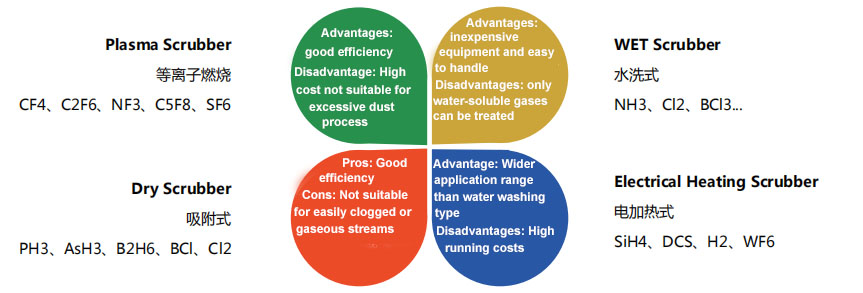Ứng dụng của khí đặc biệt trong xử lý khí thải!
Thiết bị xử lý khí thải có thể xử lý các loại khí được sử dụng trong quá trình ăn mòn và quá trình lắng đọng hơi hóa học trong ngành công nghiệp bán dẫn, tinh thể lỏng và năng lượng mặt trời, bao gồm SiH4, SiH2Cl2, PH3, B2H6, TEOS, H2, CO, NF3, SF6, C2F6, WF6, NH3, N2O, v.v.

Phương pháp xử lý khí thải
Theo đặc điểm của việc xử lý khí thải, quá trình xử lý có thể chia thành bốn loại xử lý:
1. Loại rửa bằng nước (xử lý khí ăn mòn)
2. Loại oxy hóa (xử lý khí dễ cháy và độc hại)
3. Hút phụ thuộc (theo loại vật liệu hấp thụ để xử lý khí thải tương ứng).
4.Loại đốt cháy plasma (có thể xử lý tất cả các loại khí thải).
Mỗi loại phương pháp điều trị đều có những ưu điểm và nhược điểm riêng cũng như phạm vi ứng dụng của nó. Khi phương pháp điều trị là rửa bằng nước, thiết bị rẻ và đơn giản, chỉ có thể xử lý khí tan trong nước; phạm vi ứng dụng của loại rửa điện bằng nước cao hơn so với loại rửa bằng nước, nhưng chi phí vận hành cao; loại khô có hiệu suất xử lý tốt, không áp dụng cho dòng khí dễ bị tắc nghẽn hoặc chảy.

Các hóa chất và các sản phẩm phụ thường được sử dụng trong ngành công nghiệp bán dẫn có thể được phân loại theo đặc tính hóa học và phạm vi khác nhau của chúng:
1. Khí dễ cháy như SiH4H2, v.v.
2. Khí độc như AsH3, PH3, v.v.
3. Khí ăn mòn như HF, HCl, v.v.
4. Khí nhà kính như CF4, NF3, v.v.
Do bốn loại khí trên gây hại cho môi trường hoặc cơ thể người, cần phải ngăn chặn việc thải trực tiếp chúng vào khí quyển. Vì vậy, các nhà máy bán dẫn thường được trang bị một hệ thống xử lý khí thải tập trung lớn, nhưng hệ thống này chỉ rửa khí thải bằng nước, nên phạm vi ứng dụng của nó bị giới hạn đối với các khí hòa tan trong nước ở khoảng cách xa, và không thể xử lý khí thải từ quá trình sản xuất bán dẫn với sự biến đổi liên tục và phân chia tinh tế. Do đó, cần phải chọn và kết hợp thiết bị xử lý khí thải phù hợp dựa trên đặc tính khí phát sinh từ mỗi quy trình để giải quyết vấn đề khí thải theo cách cục bộ. Vì khu vực làm việc thường nằm xa hệ thống xử lý khí thải tập trung, thường xảy ra hiện tượng kết tinh hoặc tích tụ bụi trong đường ống do đặc tính của khí, dẫn đến tắc nghẽn đường ống, gây rò rỉ khí, và trong trường hợp nghiêm trọng có thể gây nổ, không đảm bảo an toàn lao động cho nhân viên tại hiện trường. Vì vậy, cần phải trang bị thiết bị xử lý khí thải nhỏ gọn tại khu vực làm việc, phù hợp với đặc tính của khí quy trình, nhằm giảm thiểu khí thải tồn đọng trong khu vực làm việc, đảm bảo an toàn cho nhân viên.
 EN
EN
 AR
AR
 HR
HR
 CS
CS
 NL
NL
 FR
FR
 DE
DE
 IT
IT
 JA
JA
 KO
KO
 NO
NO
 PL
PL
 PT
PT
 RO
RO
 RU
RU
 ES
ES
 SV
SV
 TL
TL
 ID
ID
 VI
VI
 MT
MT
 TH
TH
 TR
TR
 AF
AF
 MS
MS
 AZ
AZ

